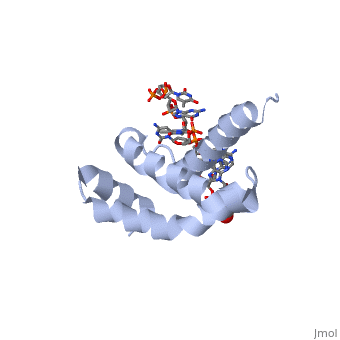Sigma factor
From Proteopedia
(Difference between revisions)
| Line 7: | Line 7: | ||
== Specific Function and Structure == | == Specific Function and Structure == | ||
| - | The '''σ-factor''' performs two chief functions: to direct the catalytic core of RNAP to the +1 start site of transcription, and finally to assist in the initiation of strand seperation of double-helical DNA, | + | The '''σ-factor''' performs two chief functions: to direct the catalytic core of RNAP to the promotoer upstream of the +1 start site of transcription, and finally to assist in the initiation of strand seperation of double-helical DNA, forming the transcription "bubble." Each gene promoter utilizes a specific promoter region about 40 bp upstream of the transcription start site, and therefore different σ-factors play a role in the regulation of different genes. This process, which includes association of the σ-factor with RNAP to recognize and open DNA at the promoter site, followed by dissociation of the σ to allow elongation, is referred to as the '''σ cycle'''. |
===Domains=== | ===Domains=== | ||
| - | There are many types of σ-subunits, and each recognizes a unique promoter sequence. Furthmore, each σ is composed of a variable number of structured domains. The simplest σ-factors have two domains, few have three, and | + | There are many types of σ-subunits, and each recognizes a unique promoter sequence. Furthmore, each unique σ is composed of a variable number of structured domains. The simplest σ-factors have two domains, few have three, and most, called '''housekeeping σ-factors''' have 4 domains, given the names σ(4), σ(3), σ(2), and σ(1.1). All domains are linked by very flexible peptide '''linkers''' which can extend very long distances. Each of these domains utilizes DNA-binding determinants, or domains that recognize specific sequences and conformations in DNA. Most commonly, these recognized sequences occur at the -35 and -10 locations upstream of the +1 site. One such DNA-binding motif, '''the helix-turn-helix motif''' (<scene name='59/591940/Hth_motif/1'>HTH</scene>), helps specifically recognize DNA promoters at both the -35 and -10 positions. This HTH motif, used by most σ-factors, maintains its specificity and accuracy by binding in the '''major groove''' of DNA, where it can interact with the base pairs in the DNA double-helix. In many prokaryotes, these portions of DNA maintain consensus adenosine and thymine sequences, such as <scene name='59/591940/Ta_sequence/1'>TATAAT</scene>. |
===Restriction=== | ===Restriction=== | ||
Normally, σ-factor domains cannot bind to promoters. These domains usually are placed in very compacted positions relative to each other, a conformation that buries DNA-binding determinants. This type of restriction is called '''conformational restriction'''. Additionally, in housekeeping σs, a domain called the '''σ(1.1)''' stabilizes the compact conformation mentioned above, thereby preventing any promoter recognition. | Normally, σ-factor domains cannot bind to promoters. These domains usually are placed in very compacted positions relative to each other, a conformation that buries DNA-binding determinants. This type of restriction is called '''conformational restriction'''. Additionally, in housekeeping σs, a domain called the '''σ(1.1)''' stabilizes the compact conformation mentioned above, thereby preventing any promoter recognition. | ||
| + | |||
| + | ===anti-σ's=== | ||
| + | An additional method of restriction is through the action of '''anti-σ's''', which act by making stable interactions with σ-domains, such as σ | ||
| + | (4), which allows them to make energy-favorable interactions with RNAP residues. This causes a cascading "peeling off" effect of other σ-domains from the RNAP, preventing any interaction with duplex DNA and inhibiting transcription in an analogous process to competitive inhibition. | ||
===Transcription Bubble=== | ===Transcription Bubble=== | ||
| - | The <scene name='59/591940/Transcription_bubble/1'>transcription bubble</scene> is | + | The <scene name='59/591940/Transcription_bubble/1'>transcription bubble</scene>, also referred to as the '''open complex''' is formed through the common '''housekeeping σ factors''' which unwind about 13 bp of duplex DNA in an ATP independent process. As such, σ factors require invariant basic and aromatic residues (Phe, Tyr, Trp) critical for this formation. The process of bubble formation begins at the -11 formation (usually A) and propogates to +1 site, through "base flipping" which interrupts the stacking interactions stabilizing the double helix conformation. As a result, -35 and -10 motif sequence recognition and strand separation are both coupled by the σ factor. |
== Gene Regulation and Differentiation == | == Gene Regulation and Differentiation == | ||
| - | + | Since σ-factors are exclusively linked to gene expression in prokaryotic organisms, the variety of σ-factors in a cell dictate how and what genes are transcribed. Specialized function in cells, therefore, is highly moderated by its arsenal of σ-subunits. In fact, cellular development and differentiation are directly impacted and carried out by "cascades" of σ-factors. In the early stages of development, '''early genes''' are transcribed by basic '''bacterial σ-factors. These genes are therefore transcribed to give new σ-factors, which in turn activate additional genes, and so on. This process of σ-factor cascades demonstrates the versatile and essential biologic functions of the RNAP subunit, σ. | |
Revision as of 01:19, 14 October 2014
| |||||||||||

